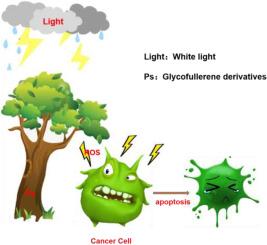当前位置:
X-MOL 学术
›
Eur. J. Med. Chem.
›
论文详情
Our official English website, www.x-mol.net, welcomes your
feedback! (Note: you will need to create a separate account there.)
Design and synthesis of glycofullerene derivatives as novel photosensitizer for potential application in PDT to treat cancer
European Journal of Medicinal Chemistry ( IF 6.0 ) Pub Date : 2024-11-06 , DOI: 10.1016/j.ejmech.2024.117009 Xue Bai, Tian Yang, Xinle Shao, Bobo Jia, Huifang Hao, Faiz-Ur Rahman, Yongmin Zhang
European Journal of Medicinal Chemistry ( IF 6.0 ) Pub Date : 2024-11-06 , DOI: 10.1016/j.ejmech.2024.117009 Xue Bai, Tian Yang, Xinle Shao, Bobo Jia, Huifang Hao, Faiz-Ur Rahman, Yongmin Zhang

|
Cancer is one of the most aggressive diseases known to humanity, characterized by low survival rates and poor prognoses. Currently, platinum-based anticancer drugs and traditional photosensitizers used in photodynamic therapy (PDT) are the most widely employed treatment modalities. However, the platinum-based medications, particularly cisplatin, the most commonly used agent, have several drawbacks. These drawbacks may include systemic toxicity, which can manifest as nephrotoxicity, neurotoxicity, ototoxicity, or emesis during treatment. Such side effects can severely impair patients and significantly diminish the overall effectiveness of therapeutic interventions. In contrast, photodynamic therapy does not present these disadvantages. PDT offers numerous benefits, including reduced long-term morbidity, minimal systemic toxicity, low invasiveness, negligible drug resistance, and temporal and geographic selectivity, all of which enhance patients' quality of life. Consequently, the search for novel, effective, and practical photosensitizers is essential. Fullerenes possess unique physicochemical properties that make them highly suitable as photosensitizers. In this study, we developed a comprehensive and straightforward synthesis for two water-soluble sugar fullerene derivatives, designated as 12 and 13 . Multiple analytical techniques, including 1 H NMR, 13 C NMR, high-resolution mass spectrometry (HRMS), Fourier-transform infrared spectroscopy (FT-IR), and ultraviolet–visible (UV–Vis) spectroscopy, collectively confirmed the chemical structures of these derivatives and validated their successful synthesis. Upon exposure to white light irradiation at an intensity of 2.5J/cm2 , compound 13 demonstrated significant biological activity against three distinct tumor cell lines: HepG2, MKN45, and RPMI 4788, with IC50 values of 5.65 μM, 2.43 μM, and 1.82 μM, respectively. This study establishes a foundation for the development of innovative clinical photosensitizers.
中文翻译:

设计和合成糖富勒烯衍生物作为新型光敏剂,在 PDT 治疗癌症的潜在应用
癌症是人类已知的最具侵袭性的疾病之一,其特点是生存率低和预后不良。目前,用于光动力疗法 (PDT) 的铂类抗癌药物和传统光敏剂是应用最广泛的治疗方式。然而,铂类药物,尤其是最常用的药物顺铂,有几个缺点。这些缺点可能包括全身毒性,可表现为肾毒性、神经毒性、耳毒性或治疗期间的呕吐。这种副作用会严重损害患者,并显着降低治疗干预的整体效果。相比之下,光动力疗法不存在这些缺点。PDT 具有许多好处,包括降低长期发病率、最小的全身毒性、低侵入性、可忽略不计的耐药性以及时间和地理选择性,所有这些都可以提高患者的生活质量。因此,寻找新颖、有效和实用的光敏剂至关重要。富勒烯具有独特的物理化学性质,使其非常适合用作光敏剂。在这项研究中,我们开发了一种全面而直接的两种水溶性糖富勒烯衍生物的合成方法,命名为 12 和 13。包括 1H NMR、13C NMR、高分辨率质谱 (HRMS)、傅里叶变换红外光谱 (FT-IR) 和紫外-可见光 (UV-Vis) 光谱在内的多种分析技术共同证实了这些衍生物的化学结构并验证了它们的成功合成。暴露于强度为 2.5J/cm2,化合物 13 对三种不同的肿瘤细胞系:HepG2、MKN45 和 RPMI 4788 表现出显著的生物活性,IC50 值分别为 5.65 μM、2.43 μM 和 1.82 μM。本研究为创新临床光敏剂的开发奠定了基础。
更新日期:2024-11-06
中文翻译:

设计和合成糖富勒烯衍生物作为新型光敏剂,在 PDT 治疗癌症的潜在应用
癌症是人类已知的最具侵袭性的疾病之一,其特点是生存率低和预后不良。目前,用于光动力疗法 (PDT) 的铂类抗癌药物和传统光敏剂是应用最广泛的治疗方式。然而,铂类药物,尤其是最常用的药物顺铂,有几个缺点。这些缺点可能包括全身毒性,可表现为肾毒性、神经毒性、耳毒性或治疗期间的呕吐。这种副作用会严重损害患者,并显着降低治疗干预的整体效果。相比之下,光动力疗法不存在这些缺点。PDT 具有许多好处,包括降低长期发病率、最小的全身毒性、低侵入性、可忽略不计的耐药性以及时间和地理选择性,所有这些都可以提高患者的生活质量。因此,寻找新颖、有效和实用的光敏剂至关重要。富勒烯具有独特的物理化学性质,使其非常适合用作光敏剂。在这项研究中,我们开发了一种全面而直接的两种水溶性糖富勒烯衍生物的合成方法,命名为 12 和 13。包括 1H NMR、13C NMR、高分辨率质谱 (HRMS)、傅里叶变换红外光谱 (FT-IR) 和紫外-可见光 (UV-Vis) 光谱在内的多种分析技术共同证实了这些衍生物的化学结构并验证了它们的成功合成。暴露于强度为 2.5J/cm2,化合物 13 对三种不同的肿瘤细胞系:HepG2、MKN45 和 RPMI 4788 表现出显著的生物活性,IC50 值分别为 5.65 μM、2.43 μM 和 1.82 μM。本研究为创新临床光敏剂的开发奠定了基础。


















































 京公网安备 11010802027423号
京公网安备 11010802027423号